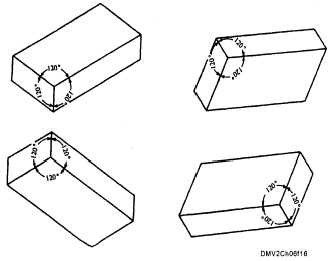Orthographic Projections, Continued
Isometric
drawing
Isometric drawings are drawn using an ordinary scale (not an isometric scale)
to lay out measurements. Images in isometric drawings are about 25 percent
larger than if rendered as an isometric projection using an isometric scale.
Proportion between the projection and drawing is the same. Pictorially, an
isometric projection and an isometric drawing appear the same. However, a
projection is foreshortened and the drawing is full scale, making it easier to
create isometric drawings.
Isometric
drawing
practices
Begin an isometric drawing by locating the isometric axes. All remaining
measurements are made parallel to the isometric axes. You cannot set off
any measurements along diagonal or nonisometric lines. Use offset or
coordinate measurements to lay out inclined or oblique surfaces or edges.
Position of the
isometric axes
The position of the isometric axes depends on the position the object is
normally viewed. You may position the isometric axes in any desired
location so long as there remains 120° between the axes. Place the long axis
horizontally for the best effect in drawing long objects.
Figure 6-16 shows how changing the position of the isometric axes changes
the object view.
Figure 6-16.—Changing isometric axes.
Continued on next page
6-20

